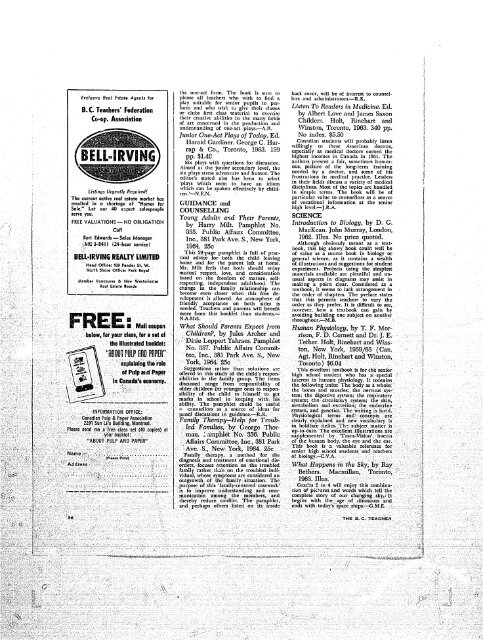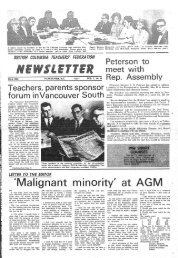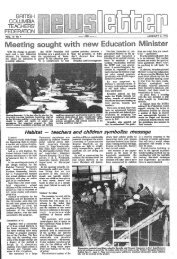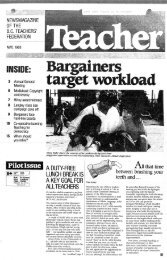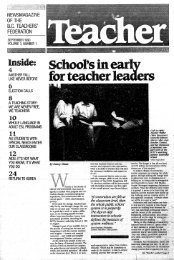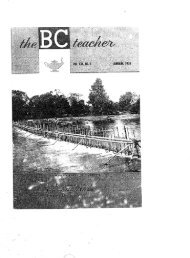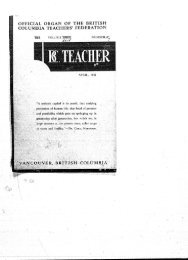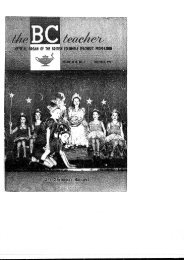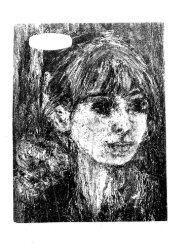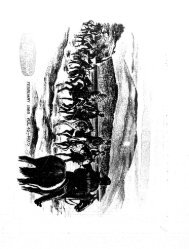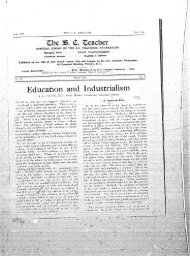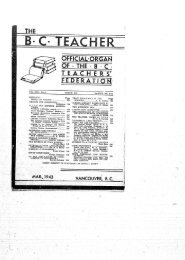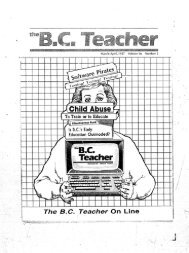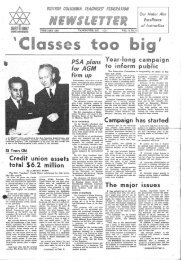Volume 44, Number 1, September/October 1964 - BCTF Home
Volume 44, Number 1, September/October 1964 - BCTF Home
Volume 44, Number 1, September/October 1964 - BCTF Home
You also want an ePaper? Increase the reach of your titles
YUMPU automatically turns print PDFs into web optimized ePapers that Google loves.
Exclusive Reel Fitat* Agents for<br />
B. C. Teachers' Federation<br />
Co-op. Association<br />
Listings Urgently Required!<br />
The current active real estate market has<br />
resulted in a shortage of "<strong>Home</strong>s for<br />
Sale." Let our 40 expert salespeople<br />
serve you.<br />
FREE VALUATIONS — NO OBLIGATION<br />
Call<br />
Bert Edwards — Sales Manager<br />
,MU 3-8411 (24-hour service)<br />
BELL-IRVING REALTY LIMITED<br />
Head Office: HO Pender St. W.<br />
North Shore Office: Park Royal<br />
Member Voncouver 6* New Westminster<br />
Root Esrc-te loords<br />
Mail coupon<br />
below, for your class, for a set of<br />
the illustrated booklet:<br />
'ABOUTPULP flRDPBPER"<br />
explaining the role<br />
of Pulp and Paper<br />
In Canada's economy.<br />
INFORMATION OFFICE:<br />
Canadian Pulp & Paper Association<br />
2280 Sun Lira Building, Montreal.<br />
Please send me a free class set (40 copies) ol<br />
- • your booklet:<br />
"ABOUT PULP AND PAPER"<br />
Name:-'.-.<br />
.'^::CVvi: ; ':' . (We"" Print) •<br />
Address.............. .<br />
the one-act form. The book is sure to<br />
please all teachers who wish to find a<br />
play suitable for senior pupils to perform<br />
and who wish to give their classes<br />
i or clubs first class material to exercise<br />
their creative abilities in the many fields<br />
of art concerned in the production and<br />
understanding of one-act plays.—A.B.<br />
Junior One-Act Plays of Today. Ed.<br />
Harold Gardiner. George C. Harrap<br />
& Co., Toronto, 1963. 159<br />
pp. $1.40<br />
Six plays with questions for discussion.<br />
Aimed at the junior secondary level, the<br />
six plays stress adventure and humor. The<br />
editor's stated aim has been to select<br />
'plays which seem to have an idiom<br />
which can be spoken effectively by children.'—N.E.N.<br />
GUIDANCE and<br />
COUNSELLING<br />
Young Adults and Their Parents,<br />
by Harry Milt. Pamphlet No.<br />
355. Public Affairs Committee,<br />
Inc., 381 Park Ave. S., New York,<br />
<strong>1964</strong>. 25c<br />
This 28-page pamphlet is full of practical<br />
advice for both the child leaving<br />
home and for the parent left at home.<br />
Mr. Milt feels that both should enjoy<br />
mutual respect, love, and consideration<br />
based on the freedom of mature, selfrespecting,<br />
independent adulthood. The<br />
change in the family relationship ran<br />
become even closer when this free development<br />
is allowed. An atmosphere of<br />
friendly acceptance on both sides is<br />
needed. Teachers and parents will benefit<br />
more from this booklet than students.—<br />
N.A.McI.<br />
What Should Parents Expect from<br />
Children?, by Jules Archer and<br />
;<br />
' Dixie Leppert Yahraes. Pampldet<br />
No. 357. Public Affairs Committee,<br />
Inc., 381 Park Ave. S., New<br />
York, <strong>1964</strong>. 25c<br />
Suggestions rather than solutions are<br />
offered in this study of the child's responsibilities<br />
in the family group. The items<br />
discussed range from responsibility of<br />
older children for younger ones to rcspon- ,<br />
sibility of the child to himself to get<br />
marks' in school in keeping with his<br />
ability. The pamphlet could be useful<br />
t> counsellors as a source of ideas for<br />
panel discussions in guidance.—R.K.<br />
Family Therapy—Help for Troubled<br />
Families, by George Thorman.<br />
lamphlet No. 356. Public<br />
Affairs Committee, Inc., 381 Park<br />
Ave. S., New York, <strong>1964</strong>. 25c<br />
Family therapy, a method for the<br />
diagnosis and treatment of emotional disorders,<br />
focuses attention on the troubled<br />
family rather than on the troubled individual,<br />
whose symptoms are considered an<br />
outgrowth of the family situation. Thepurpose<br />
of this 'family-centered casework'<br />
is to improve understanding and communication<br />
among the ' members, and<br />
thereby reduce conflict. The pamphlet,<br />
and perhaps others listed on its inside<br />
back cover, will be of interest to counsellors<br />
and administrators.—R.K.<br />
Listen To Readers in Medicine. Ed.<br />
by Albert Love and James Saxon<br />
Childers. Holt, Rinehart and<br />
Winston, Toronto, 1963. 340 pp.<br />
No index. $5.50<br />
Canadian students will probably listen<br />
willingly to these American doctors,<br />
especially as medical doctors earned the<br />
highest incomes in Canada in 1961. The<br />
authors present a fair, sometimes humorous,<br />
picture of the long-term training<br />
needed by a doctor, and some of his<br />
frustrations in medical practice. Leaders<br />
in their fields discuss a variety of medical<br />
disciplines. Most of the topics arc handled<br />
in simple terms. The book will be of<br />
particular value to counsellors as a source<br />
of vocational information at the senior<br />
high level.—J.R.A.<br />
SCIENCE<br />
Introduction to Biology, by D. G.<br />
MacKean. John Murray, London,<br />
1962. Illus. No price quoted.<br />
Although obviously meant as a - textbook,<br />
this big showy book could well be<br />
of value as a source book in biology or<br />
general science, as it contains a wealth<br />
of illustrations and suggestions for student<br />
experiment. Projects using the simplest<br />
materials available are plentiful and unusual<br />
aspects in diagrams may assist in<br />
making a point clear. Considered as a<br />
textbook, it seems to lack arrangement in<br />
the order of chapters. The preface states<br />
that this permits teachers to vary the<br />
order as they prefer. It is difficult to sec,<br />
however, how a textbook can gain by<br />
avoiding building one subject on another<br />
throughout.—M.B.<br />
Human Physiology, by T. F. Morrison,<br />
F. D. Cornett and Dr. J. E.<br />
Tether. Holt, Rinehart and Winston,<br />
New York, 1959/63 (Can.<br />
Agt. Holt, Rinehart and Winston,<br />
Toronto) $6.04<br />
This excellent textbook is for the senior<br />
high school student who has a: special<br />
interest in human physiology. It contains<br />
the following units: The body as a whole;'<br />
the bones and muscles; the nervous sys-'<br />
tern; the digestive system; the respiratory<br />
system; 'the circulatory system; the skin,<br />
metabolism and excretion; the endocrine<br />
system, and genetics. The writing is lucid.<br />
Physiological terms and ; concepts are<br />
clearly explained and new vocabulary is<br />
in boldface italics. The subject matter is<br />
up-to-date. The excellent illustrations are<br />
supplemented by 'Trans-Vision' inserts<br />
of the human body, the eye and the ear.<br />
This book is a valuable reference for<br />
senior high school students and teachers<br />
of biology.—C.V.A.<br />
What Happens in the Sky, by Ray<br />
Bethers. Macmillan, Toronto,<br />
1963. Illus.<br />
Grades 2 to 4 will enjoy this combination<br />
of pictures and words which tell the<br />
complete story of our changing sky.> It<br />
begins with the age of dinosaurs and<br />
ends with today's space ships.—G.M.E.<br />
THE B. C. TEACHER


